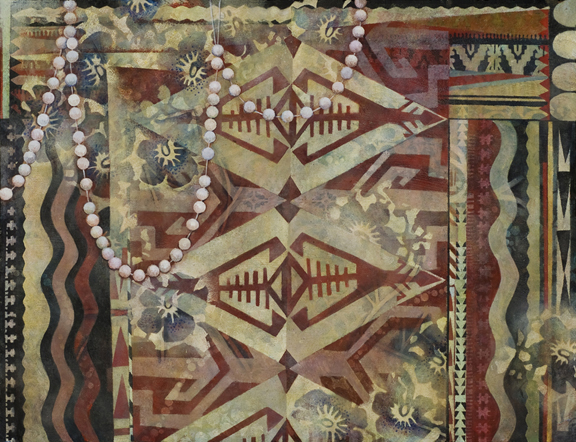Painting Fabric Patterns in Portland
Alice Spencer has been an important member of the Portland, Maine, arts community for 30 years. In addition to being a fine painter and printmaker, she is a co-founder of the Peregrine Press printmaking collaborative, a former member of the Maine College of Art board of directors, and chair of the City of Portland Public […]

Blanket, 50×40, Acrylic on gesso & sand on board
Alice Spencer has been an important member of the Portland, Maine, arts community for 30 years. In addition to being a fine painter and printmaker, she is a co-founder of the Peregrine Press printmaking collaborative, a former member of the Maine College of Art board of directors, and chair of the City of Portland Public Art Committee.
When I first saw Alice Spencer’s work in the late 1970s, she was painting boldly expressive landscapes in which she picked out and stylized elements of the natural world. In her recent work, she is up to something quite different, albeit related.
Alice Spencer: Fabricating Time (through January 11) fills the three floors of the University of New England Gallery of Art with a wonderfully colorful exhibition of both fabrics Spencer has collected in world travels and the paintings they have inspired and informed. There are elaborately stitched tent panels from Kazakstan, panels from an Ecuadorian shaman’s robe, a batik breast wrappers from Java, an intricately stitched, dyed, and pleated skirt from China, and a glorious 19th century woman’s robe from Uzbekistan, among other textile treasures from Spencer’s personal collection.
What these native textiles have in common with Spencer’s acrylic on gessoed and sanded board paintings is an obsession both with pattern and with making. Spencer uses hand-made and found stencils to apply patterns to her paintings. To her credit, Spencer is in no way literal in the way she translates the repetitive scrolled, geometric, floral, and abstract pattern language of hand-made fabrics into the overlay patterns of her paintings. Even when paintings depict robes, blankets, shawls, and scarves, they are imaginative two-dimensional equivalents, not pictures of real garments. And not all of the patterns in the paintings appear to derive from fabric. There are also elements that seem to be chain link fencing and even the golden arches of McDonald’s.
“Each painting is built in layers like an archeological dig in reverse,” Spencer writes in the Fabricating Time catalogue. “By layering these images, my paintings become maps or palimpsests of human experience unfolding in time.”
Spencer emphasizes that the textiles in her collection are not rare or expensive. “They were chosen,” she writes, “because they were made by hand and embodied the authentic weaving and embroidery traditions still alive around the world.”
Henri Matisse is perhaps the artist best known for appropriating the decorative arts as a source for fine art, but the time Alice Spencer seems to be fabricating in Fabricating Time is the 1970s. Pattern painters of the 1970s such as Miriam Schapiro, Kim MacConnel, and Joyce Kozloff looted and liberated craft traditions to make paintings that were defiantly decorative and beautiful. It is to this aesthetic that Alice Spencer’s paintings speak most directly.
Step into the gallery out of a bleak December day and be warmed by the sheer visual pleasure of Fabricating Time.
University of New England Gallery of Art, 716 Stevens Avenue, Portland, Maine, 207-221-4499.
Edgar Allen Beem
Take a look at art in New England with Edgar Allen Beem. He’s been art critic for the Portland Independent, art critic and feature writer for Maine Times, and now is a freelance writer for Yankee, Down East, Boston Globe Magazine, The Forecaster, and Photo District News. He’s the author of Maine Art Now (1990) and Maine: The Spirit of America (2000).
More by Edgar Allen Beem

